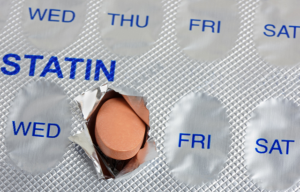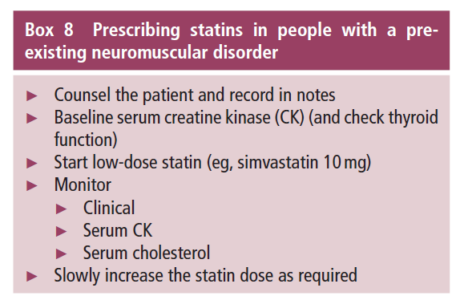Weighing risks and benefits
 We are often asked about whether people with FSHD can safely take statins. Statins are the most widely prescribed drug in the world and are used to lower blood cholesterol, which is associated with reducing the risk of cardiovascular disease. However, they sometimes affect the muscles, so people with FSHD are understandably concerned.
We are often asked about whether people with FSHD can safely take statins. Statins are the most widely prescribed drug in the world and are used to lower blood cholesterol, which is associated with reducing the risk of cardiovascular disease. However, they sometimes affect the muscles, so people with FSHD are understandably concerned.
Here is a very helpful article on the risks and benefits of taking statins from the MD UK website. Reposted here with permission.
Note that there are alternatives to statins for lowering cholesterol (from WebMD).
Reference: Hilton-Jones, Practical Neurology 2018
We asked Dr David Hilton-Jones, Consultant Neurologist at John Radcliffe Hospital to answer some of these questions for you. He has used his many years of clinical experience, and work with hundreds of people with muscle-wasting conditions, to share his considered opinion with you. You might find this Q and A useful to share with your GP or consultant.
What are statins and why do people take them?
Statins block the synthesis of cholesterol (a type of fat). Although there is some debate, the general consensus is that statins can provide a major health benefit, especially in those at high risk. For example, they can be of benefit to those with a family history of high cholesterol, and to those with diseases such as diabetes.
People with high levels of cholesterol in their blood are at increased risk of the arteries furring up (atheroma). The blockage of an artery:
- to the brain, causes a stroke
- to the heart, causes a heart attack
- to the legs (narrowing of the arteries), causes claudication (pain in the muscles on walking).
Some of the cholesterol comes from food, but most is synthesised in the body. Reducing the level of cholesterol reduces the risk of atheroma and its consequences. Diet helps a little, but statins have a potent effect on reducing cholesterol levels.
Is it OK for me to take a statin?
It is widely known that statins can cause muscle problems. Concerns have been raised that those with a muscle condition, and those carrying a mutated gene but without muscle problems themselves, may be more susceptible to such problems. Although simple precautions need to be taken, in general such people can safely take statins. It would be wrong to deprive them of the potential benefits of these drugs.
What muscle problems can statins cause, and why?
These questions are still being investigated but currently we believe that there are three main types of problem:
- about five to ten percent of people taking statins complain of muscle aches and pains. Often a blood test will show an increase in the blood creatine kinase (CK) level. This is a non-specific marker of muscle damage and CK is increased in many muscle diseases, with very high levels in conditions like Duchenne muscular dystrophy. Many people can tolerate these symptoms, or they will improve with a lower dose of the same statin or changing to a different brand. The symptoms resolve if the statin is stopped.
- extremely rarely (probably in fewer than one in 10,000 people), statins may cause rhabdomyolysis. In these extremely rare cases, over the course of a few hours the patient develops widespread muscle pain and weakness owing to extensive breakdown of muscle. CK, and a protein called myoglobin, are released from the damaged muscle into the blood. The blood CK level is very high. The myoglobin escapes through the kidneys and the urine becomes dark red/black. The myoglobin can damage the kidneys causing kidney failure. Although this can be treated, by dialysis, it can in very rare circumstances be fatal. This serious and rare complication is most likely to happen in people taking very high doses of statins, particularly in combination with other drugs.
- very rarely, statins can trigger a disturbance of the immune system. It has recently been found that the body produces antibodies that attack the muscle (this condition is called myositis). This causes weakness and an increase in CK levels. It may resolve if the statin is stopped, but sometimes it continues and it is necessary to use steroids (e.g. prednisolone) to bring it under control.
The first two points above probably relate to the fact that statins block the synthesis of substances other than cholesterol, and this metabolic effect leads to the symptoms. Co-enzyme Q10 (CoQ) is an important muscle protein and is known to be deficient in a few rare muscle conditions. Statins may affect its synthesis and at one time it was suspected that low CoQ levels might explain some cases of statin toxicity, leading people to prescribe CoQ to try to prevent problems. There is no good evidence that this has any beneficial effect and we don’t recommend it. The third point above is different, as here the statin upsets the body’s immune system.
If I have a muscle condition, or am a carrier of a muscle condition, am I at greater risk of statin-induced muscle problems?
It must be said that this is still a controversial area, despite worldwide experience of treating many millions of people with statins, many of whom fall into this category. As noted above, the two most common muscle consequences of taking statins are muscle aches and pains and a rise in the blood CK. These are also two of the most common features of muscle conditions. There is very little evidence that the more serious complications of statins (the second and third points above) are any more likely to happen in those with pre-existing muscle conditions or in carriers of muscle conditions (such as women carrying mutations in the dystrophin gene).
So, can I take a statin?
On the basis of extensive personal experience, and the available medical literature, we would advise a step-by-step approach.
- Is there a good medical reason for taking a statin? That may seem an obvious question, but in the general population, some people at very low risk of atheroma are being put on statins. This can be either by their own choice, or by prescription (although sometimes without good evidence that benefits outweigh risk). If there is a good reason for treatment, then continue on to the next step.
Advice for doctors

- Advise the patient of all of the above information so they are adequately informed to make their own choice. If they decide to go ahead, continue to the next step.
- Check the CK as a baseline for the future. At the same time, do a blood test to check thyroid gland function – under-activity of the thyroid is common in the general population and two of its consequences include increasing the blood cholesterol and CK levels.
- Start with a lower dose of the statin than you might normally do. Simvastatin is the most widely prescribed drug and the starting dose should be 10mg.
- If, after a few weeks, the person has noted no problems, for example, increased muscle pain or weakness, then increase the dose to 20mg.
- After three months, check the cholesterol. If it has not come down adequately, and there have been no side-effects from the 20mg dose, increase to 40mg (as long as the patient is not taking any other drug known to interfere with statins, such as amlodipine for blood pressure. This is true for anybody, not just those with a muscle condition). Higher doses than 40mg should generally not be given as there is good evidence that this substantially increases the risk of problems.
- If, at any time, the person develops muscle pain, then repeat the CK measurements. If the pains are acceptable, and there has not been a very large increase in the CK, then treatment may be continued.
- If the side-effects are unacceptable, or there is a very large persistent increase in CK, then the drug should be stopped. Consideration can then be given either to trying a different statin, or using an alternative form of drug treatment.
- If at any time the person feels they are having marked symptoms, the statin should be stopped immediately and the CK checked as soon as possible.


For me taking a statin as advised for a precaution by a cardiologist was a disaster for my FSHD. I had very limited symptoms from the FSHD but over the next two years I began to lose significant muscle tome in my legs. My neurologist checked me ovver, and even extolled the benefits of statins. It was only when he referred me to a more experienced colleague that I was advised that statins were not a good idea, and a CK level test was essential. THe levels were very high and I came off the drugs after which they returned to normal, but the damage to muscle tone was done and irreparable. The message should be to exercise extreme caution with these drugs. Of course they have major benefits for many, but the risks for FSHD patients are not well understood in the general medical profession (due to the rarity of the condition), and more education is urgently needed on this.
Thank you for providing such a comprehensive and practical guide. Your blog has become a valuable resource for me, and I’m sure it will help many others on their journey to better manage High cholesterol. Looking forward to more insightful content from you.
This is the exact program I followed to dissolve plaque in my clogged arteries naturally ( cholesterol.1remedy.net ). You’ll be absolutely thrilled with the step-by-step plan that guides you through the ultimate solution to clear out your clogged arteries, that you’ll only have one regret — and that is this: Not having had this valuable resource years ago!